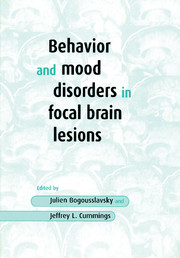Book contents
- Frontmatter
- Dedication
- Contents
- List of contributors
- Preface
- Acknowledgments
- 1 Emotional consequences of focal brain lesions: an overview
- 2 The evaluation of mood and behavior in patients with focal brain lesions
- 3 Methodological issues in studying secondary mood disorders
- 4 Emotional behavior in acute brain lesions
- 5 Depression and lesion location in stroke
- 6 Mood and behavior in disorders of the basal ganglia
- 7 Mania and manic-like disorders
- 8 Behavioral and emotional changes after focal frontal lobe damage
- 9 Disorders of motivation
- 10 Thalamic behavioral syndromes
- 11 Obsessive-compulsive disorders in association with focal brain lesions
- 12 Emotional dysprosody and similar dysfunctions
- 13 Temporal lobe behavioral syndromes
- 14 Neural correlates of violent behavior
- 15 Focal lesions and psychosis
- 16 Alterations in sexual behavior following focal brain injury
- 17 Anosognosia
- 18 Acute confusional states and delirium
- Index
6 - Mood and behavior in disorders of the basal ganglia
Published online by Cambridge University Press: 05 August 2016
- Frontmatter
- Dedication
- Contents
- List of contributors
- Preface
- Acknowledgments
- 1 Emotional consequences of focal brain lesions: an overview
- 2 The evaluation of mood and behavior in patients with focal brain lesions
- 3 Methodological issues in studying secondary mood disorders
- 4 Emotional behavior in acute brain lesions
- 5 Depression and lesion location in stroke
- 6 Mood and behavior in disorders of the basal ganglia
- 7 Mania and manic-like disorders
- 8 Behavioral and emotional changes after focal frontal lobe damage
- 9 Disorders of motivation
- 10 Thalamic behavioral syndromes
- 11 Obsessive-compulsive disorders in association with focal brain lesions
- 12 Emotional dysprosody and similar dysfunctions
- 13 Temporal lobe behavioral syndromes
- 14 Neural correlates of violent behavior
- 15 Focal lesions and psychosis
- 16 Alterations in sexual behavior following focal brain injury
- 17 Anosognosia
- 18 Acute confusional states and delirium
- Index
Summary
Introduction: general concepts, anatomy, physiology, and neurochemistry
The basal ganglia have been associated with motor control since Wilson's Croonian lecture (1925), but Kleist (1922), and later others, extended their role to behavior, cognitive functions, emotions, motivation, reward, personality and character (for a summary, see Weiner and Lang, 1995). With their strategic location within the brain, and their rich and reciprocal connection with cortical sensorimotor areas, but also with limbic, paralimbic, midbrain, and diencephalic structures, the basal ganglia have all the rationale for processing the interface between internal personal drives (basic instincts, mood, motivations, needs) and the external world's stimuli, i.e., the modulation and motor expression of emotions, moods, needs, drives or motivation and cognition through corticospinal volitional axial and distal pathways (Kuypers, 1982), but also through emotional limbic motor-visceromotor pathways (Holstege, 1992).
Fronto-subcortical circuits
The basal ganglia are included in retroactive loops on cortical activity and cannot any more be considered functional as separate anatomical entities. Therefore, a lesion at any level of this network can be followed by a common syndromic symptomatology. After a first attempt by Kleist (1922), Alexander et al. (1986) described five frontal-based ganglia-fhalamocortical segregated and parallel loops (there are probably more to discover), which have been designated as motor, oculomotor, dorsolateral prefrontal (DLPF), orbitofrontal (OF), and anterior cingulate (AC) fronto-subcortical circuits, which participate in the frontal management of primitive unmodulated drives and behaviors, that are ingrained in limbic, thalamic, and paralimbic structures. Each of these circuits has two pathways, one direct, projecting from the cortex to the caudate, external pallidum, internal pallidum/substantia nigra, and one indirect pathway, from external pallidum to the subthalamic nucleus and back to the internal pallidum, from where both circuits project together to the ventrolateral thalamic nucleus and back to their respective cortical areas.
The key role of the basal ganglia is their action as a filter, or gate processor on convergent motor, mood, and cognitive behavior (for a review, see Kimura and Graybiel, 1995). The overall activity of the basal ganglia is dichotomic, binary, organized within reciprocal zones of excitation and inhibition: either a release or activation, mediated by the direct pathways, promoting activity in recurrent, positive feedback loops, helped by dopamine, which also inhibits the indirect (inhibitory) pathway, or an inhibition or deficit, generated by the indirect inhibitor pathways, leading to the suppression of unwanted movements, thoughts, behaviors, or emotions.
- Type
- Chapter
- Information
- Behavior and Mood Disorders in Focal Brain Lesions , pp. 122 - 201Publisher: Cambridge University PressPrint publication year: 2000
- 3
- Cited by



